|
Rafal Wladyslaw Kiernicki
Rafal Wladyslaw Kiernicki ( uk, Рафал Владислав Керницький; pl, Rafał Władysław Kiernicki; 3 May 1912 – 23 November 1995) was a Roman Catholic prelate from Ukraine as the Titular Bishop of Dura and Auxiliary bishop of Archdiocese of Lviv since 16 January 1991 until his death on 23 November 1995. Life Kiernicki was born in the peasant Roman Catholic family of Antoni and Michaela (née Swiatłowska) Kiernicki in a present day of the territory of Kolomyia Raion of Ivano-Frankivsk Oblast, Ukraine. After graduation of the primary school in his native village (1920–1924) and the neighbouring village Hvozdets (1924–1927), he continued to study in a Franciscan gymnasium in Lviv (1927–1934). While studied in gymnasium, he joined the Order of Friars Minor Conventual in 1930; made a profession on September 4, 1931 and a solemn profession on October 4, 1934. Kiernicki subsequently made a philosophical and theological studies at the Franciscan Theological ... [...More Info...] [...Related Items...] OR: [Wikipedia] [Google] [Baidu] |
Servant Of God
"Servant of God" is a title used in the Catholic Church to indicate that an individual is on the first step toward possible canonization as a saint. Terminology The expression "servant of God" appears nine times in the Bible, the first five in the Old Testament, the last four in the New Testament, New. The Hebrew Bible refers to "Moses the servant of Elohim" (עֶֽבֶד הָאֱלֹהִ֛ים ''‘eḇeḏ-hā’ĕlōhîm''; , , , and ). , ). refers to Joshua as ''‘eḇeḏ Yahweh'' (עֶ֣בֶד יְהוָ֑ה). The New Testament also describes Moses in this way in (τοῦ δούλου τοῦ Θεοῦ, ''tou doulou tou Theou''). Paul the Apostle, Paul calls himself "a servant of God" in (δοῦλος Θεοῦ, ''doulos Theou''), while Epistle of James, James calls himself "a servant of God and the Lord Jesus Christ" (θεοῦ καὶ κυρίου Ἰησοῦ χριστοῦ δοῦλος, ''Theou kai Kyriou Iēsou Christou doulos'') in . describes "servants of God" ... [...More Info...] [...Related Items...] OR: [Wikipedia] [Google] [Baidu] |
Order Of Friars Minor Conventual
The Order of Friars Minor Conventual (OFM Conv) is a male religious fraternity in the Roman Catholic Church that is a branch of the Franciscans. The friars in OFM CONV are also known as Conventual Franciscans, or Minorites. Dating back to the 13th century, OFM Conv. has provinces worldwide. Dressed in serge habits with white cords, the friars teach in schools, serve as chaplains, run hospitals and provide aid to the poor. Background The OFM Conv. is a mendicant Catholic religious order. It is one of three separate fraternities that make up the First Order of St. Francis, for friars only. The Second Order is the Poor Clares, for nuns only. The Third Order can be for men or women, secular or religious. Source of the name There are several theories as to the source of the name "conventual": * In the Bull ''Cum tamquam veri'' of 5 April 1250, Pope Innocent IV decreed that Franciscan churches where convents existed might be called "Conventual churches". * A second theory ... [...More Info...] [...Related Items...] OR: [Wikipedia] [Google] [Baidu] |
Pope John Paul II
Pope John Paul II ( la, Ioannes Paulus II; it, Giovanni Paolo II; pl, Jan Paweł II; born Karol Józef Wojtyła ; 18 May 19202 April 2005) was the head of the Catholic Church and sovereign of the Vatican City State from 1978 until his death in April 2005, and was later canonised as Pope Saint John Paul II. He was elected pope by the second papal conclave of 1978, which was called after John Paul I, who had been elected in August to succeed Pope Paul VI, died after 33 days. Cardinal Wojtyła was elected on the third day of the conclave and adopted the name of his predecessor in tribute to him. Born in Poland, John Paul II was the first non-Italian pope since Adrian VI in the 16th century and the second-longest-serving pope after Pius IX in modern history. John Paul II attempted to improve the Catholic Church's relations with Judaism, Islam, and the Eastern Orthodox Church. He maintained the church's previous positions on such matters as abortion, artificia ... [...More Info...] [...Related Items...] OR: [Wikipedia] [Google] [Baidu] |
Religion In The Soviet Union
The Soviet Union was established by the Bolsheviks in 1922, in place of the Russian Empire. At the time of the 1917 Revolution, the Russian Orthodox Church was deeply integrated into the autocratic state, enjoying official status. This was a significant factor that contributed to the Bolshevik attitude to religion and the steps they took to control it. Thus the USSR became the first state to have as one objective of its official ideology the elimination of existing religion, and the prevention of future implanting of religious belief, with the goal of establishing state atheism (''gosateizm''). Under the doctrine of state atheism in the Soviet Union, there was a "government-sponsored program of conversion to atheism" conducted by Communists. The Communist government targeted religions based on State interests, and while most organized religions were never outlawed, religious property was confiscated, believers were harassed, and religion was ridiculed while atheism was propagate ... [...More Info...] [...Related Items...] OR: [Wikipedia] [Google] [Baidu] |
Soviet Union
The Soviet Union,. officially the Union of Soviet Socialist Republics. (USSR),. was a transcontinental country that spanned much of Eurasia from 1922 to 1991. A flagship communist state, it was nominally a federal union of fifteen national republics; in practice, both its government and its economy were highly centralized until its final years. It was a one-party state governed by the Communist Party of the Soviet Union, with the city of Moscow serving as its capital as well as that of its largest and most populous republic: the Russian SFSR. Other major cities included Leningrad (Russian SFSR), Kiev (Ukrainian SSR), Minsk ( Byelorussian SSR), Tashkent (Uzbek SSR), Alma-Ata (Kazakh SSR), and Novosibirsk (Russian SFSR). It was the largest country in the world, covering over and spanning eleven time zones. The country's roots lay in the October Revolution of 1917, when the Bolsheviks, under the leadership of Vladimir Lenin, overthrew the Russian Provisional Government ... [...More Info...] [...Related Items...] OR: [Wikipedia] [Google] [Baidu] |
Polish Population Transfers (1944–1946)
The Polish population transfers in 1944–1946 from the eastern half of prewar Second Polish Republic, Poland (also known as the expulsions of Poles from the Kresy macroregion), were the forced migrations of Poles toward the end and in the aftermath of World War II. These were the result of Soviet Union, Soviet policy that was ratified by the Allies of World War II, Allies. Similarly, the Soviet Union had enforced policies between 1939 and 1941 which targeted and expelled ethnic Poles residing in the Soviet zone of occupation following the Nazi-Soviet invasion of Poland. The second wave of expulsions resulted from the retaking of Poland by the Red Army during the Soviet counter-offensive. It took over Territorial changes of Poland immediately after World War II, territory for its republic of Ukraine, a shift that was ratified at the end of World War II by the Soviet Union's then Allies of the West. The postwar population transfers, targeting Polish nationals, were part of an offi ... [...More Info...] [...Related Items...] OR: [Wikipedia] [Google] [Baidu] |
Brygidki
Brygidki ( uk, Бригідки) is a prison in the building of a former Bridgettine nunnery in Lviv, Ukraine. History The monastery was founded in 1614 at the behest of Anna Fastkowska and Anna Poradowska for girls from noble families. After the Partition of Poland the Austrian administration decided to secularise the convent. In 1784 the Brygidki building was turned into a prison, where death sentences would be carried out on a regular basis until the 1980s. Taken over by the Soviet Union after Soviet invasion of Poland in 1939, the prison was one of three sites of mass murder of political prisoners by NKVD in Ukraine in June 1941 as the Soviets were retreating before the Nazi German invasion. Approximately 7,000 prisoners - primarily Poles and Ukrainians - died in Lviv in that event. During the German occupation, mass murders of Polish, Jewish and Ukrainian civilians occurred in Brygidki. It was the site of the murder of Prof. Kazimierz Bartel during the Massacre of Lwów pro ... [...More Info...] [...Related Items...] OR: [Wikipedia] [Google] [Baidu] |
NKVD
The People's Commissariat for Internal Affairs (russian: Наро́дный комиссариа́т вну́тренних дел, Naródnyy komissariát vnútrennikh del, ), abbreviated NKVD ( ), was the interior ministry of the Soviet Union. Established in 1917 as NKVD of the Russian Soviet Federative Socialist Republic, the agency was originally tasked with conducting regular police work and overseeing the country's prisons and labor camps. It was disbanded in 1930, with its functions being dispersed among other agencies, only to be reinstated as an all-union commissariat in 1934. The functions of the OGPU (the secret police organization) were transferred to the NKVD around the year 1930, giving it a monopoly over law enforcement activities that lasted until the end of World War II. During this period, the NKVD included both ordinary public order activities, and secret police activities. The NKVD is known for its role in political repression and for carrying out the Great ... [...More Info...] [...Related Items...] OR: [Wikipedia] [Google] [Baidu] |
Home Army
The Home Army ( pl, Armia Krajowa, abbreviated AK; ) was the dominant resistance movement in German-occupied Poland during World War II. The Home Army was formed in February 1942 from the earlier Związek Walki Zbrojnej (Armed Resistance) established in the aftermath of the German and Soviet invasions in September 1939. Over the next two years, the Home Army absorbed most of the other Polish partisans and underground forces. Its allegiance was to the Polish government-in-exile in London, and it constituted the armed wing of what came to be known as the Polish Underground State. Estimates of the Home Army's 1944 strength range between 200,000 and 600,000. The latter number made the Home Army not only Poland's largest underground resistance movement but, along with Soviet and Yugoslav partisans, one of Europe's largest World War II underground movements. The Home Army sabotaged German transports bound for the Eastern Front in the Soviet Union, destroying German supplies and ty ... [...More Info...] [...Related Items...] OR: [Wikipedia] [Google] [Baidu] |
Western Ukraine
Western Ukraine or West Ukraine ( uk, Західна Україна, Zakhidna Ukraina or , ) is the territory of Ukraine linked to the former Kingdom of Galicia–Volhynia, which was part of the Polish–Lithuanian Commonwealth, the Austrian Empire, Austria-Hungary and the Second Polish Republic, and came fully under the control of the Soviet Union (via the Ukrainian Soviet Socialist Republic) only in 1939, following the Molotov–Ribbentrop Pact. There is no universally accepted definition of the territory's boundaries (see the map, right), but the contemporary Ukrainian administrative regions or Oblasts of Chernivtsi, Ivano-Frankovsk, Lviv, Ternopil and Transcarpathia (which were part of the former Austro-Hungarian Empire) are nearly always included and the Lutsk and Rivne Oblasts (parts of the annexed from Poland during its Third Partition) are usually included. It is less common to include the Khmelnytski and, especially, the Vinnytsia and Zhytomyr Oblasts in this c ... [...More Info...] [...Related Items...] OR: [Wikipedia] [Google] [Baidu] |
Priest
A priest is a religious leader authorized to perform the sacred rituals of a religion, especially as a mediatory agent between humans and one or more deities. They also have the authority or power to administer religious rites; in particular, rites of sacrifice to, and propitiation of, a deity or deities. Their office or position is the 'priesthood', a term which also may apply to such persons collectively. A priest may have the duty to hear confessions periodically, give marriage counseling, provide prenuptial counseling, give spiritual direction, teach catechism, or visit those confined indoors, such as the sick in hospitals and nursing homes. Description According to the trifunctional hypothesis of prehistoric Proto-Indo-European society, priests have existed since the earliest of times and in the simplest societies, most likely as a result of agricultural surplus and consequent social stratification. The necessity to read sacred texts and keep temple or church rec ... [...More Info...] [...Related Items...] OR: [Wikipedia] [Google] [Baidu] |
Roman Catholic Seminary In Lviv
Seminary in Lviv (now the Seminary of the Archdiocese of Lviv in Lviv-Bryukhovychi) - Roman Catholic seminary founded in Lviv in 1703. The university was founded in 1703 as a seminary Cathedral in Lviv. After the partition of Polish, Austrian authorities in 1783 in Lviv formed the so-called General Seminar for all the dioceses of Galicia. The place of the seminar were the buildings of former monastery Carmelite Calced in Lviv (later Ossolineum. In 1814, a seminar Lviv separated from the Seminar General. The new location of the seminar were in buildings post-monastery Discalced Carmelites. Until World War II alumni seminar benefited from the intellectual formation of the Faculty of Theology of the University of Jan Kazimierz Lviv. After the end of World War II and the deportation of Poles from Lviv, in 1945 the seminary was moved to Kalwaria Zebrzydowska, but already in 1950, the communist authorities liquidated them. The seminar resumed its operations on Dec. 12, 1996 Street. Lviv ... [...More Info...] [...Related Items...] OR: [Wikipedia] [Google] [Baidu] |




.png)



